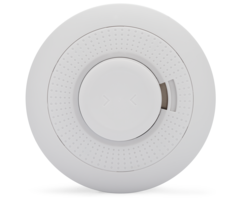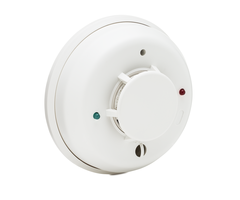Combination Smoke/Heat Detectors



Combination smoke and heat detectors make for an important addition to any system. Monitoring a home or business for a fire is crucial. You will want to ensure that your system responds as quickly as possible if there is every a fire. The best way to do this is with combination smoke and heat detectors. With dual detection methods, these sensors respond quickly to all types of fires, and they provide supreme life-safety functionality.
As the name implies, a combination smoke detector will respond to both smoke and high heat. With any serious fire, there will be smoke. These sensor are specifically designed to detect these fine airborne particles and activate quickly during a fire. Meanwhile, the heat sensor responds to unusually high temperatures that would only be present during a fire. As long as one of these sensors activates, the device will alert the system and trigger a fire alarm.
Combination smoke and heat detectors are enrolled as 24-hour zones. This means that they can cause a fire alarm upon activating, regardless of whether the system is in an armed or disarmed state. This is important, as you will want to receive emergency help for a fire regardless of the current arming state. If you are at home sleeping with your system disarmed, a fire alarm can occur. A fire alarm can also occur if you are away from home with the system armed. Either way, your system will take appropriate action.
In order to take full advantage of a combination smoke and heat detector, you will definitely want to obtain alarm monitoring service for your system. This is the only way that your system will be able to send out alerts and notifications regarding a fire alarm. If you have central station monitoring, most jurisdictions will allow for automatic emergency fire dispatch in the event of a fire alarm. And if you have self-monitoring you can still receive text and/or email alerts regarding a fire alarm so that you can notify the fire department yourself. Either option is better than an unmonitored system.
Like most sensors, combination smoke and heat detectors are available in wireless and hardwired varieties. With the rise of wireless alarm systems, wireless sensors are now the most popular option. If you go this route, you must make sure the wireless combination smoke and heat detectors you use communicate at a wireless frequency that is compatible with your system. Hardwired smoke and heat detectors are normally used with hardwired systems only. But there are some wired to wireless converters like the Qolsys IQ Hardwire 16-F that will let you bring over wired smoke and heat detectors for use with a wireless panel.
Remember, you should install fire-safety sensors outside of all sleeping area, in hallways, and in large central locations. You should have at least one of these sensors installed on each floor of the building. This is the best way to ensure that your system responds as quickly as possible to a fire. Every second counts when it comes to a fire, and you want to make sure that these sensors will activate quickly. You should also test these sensors regularly to ensure proper working order. Daylight Savings Time is often seen as a good time to test these sensors.


